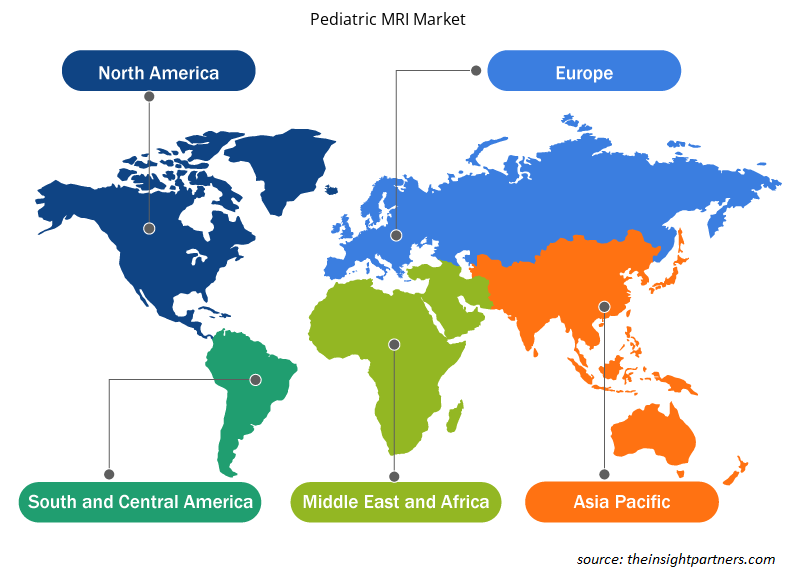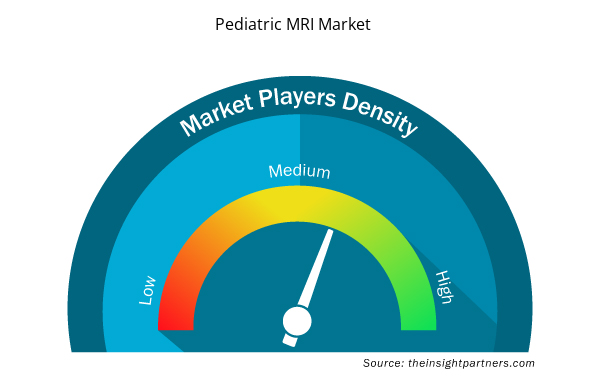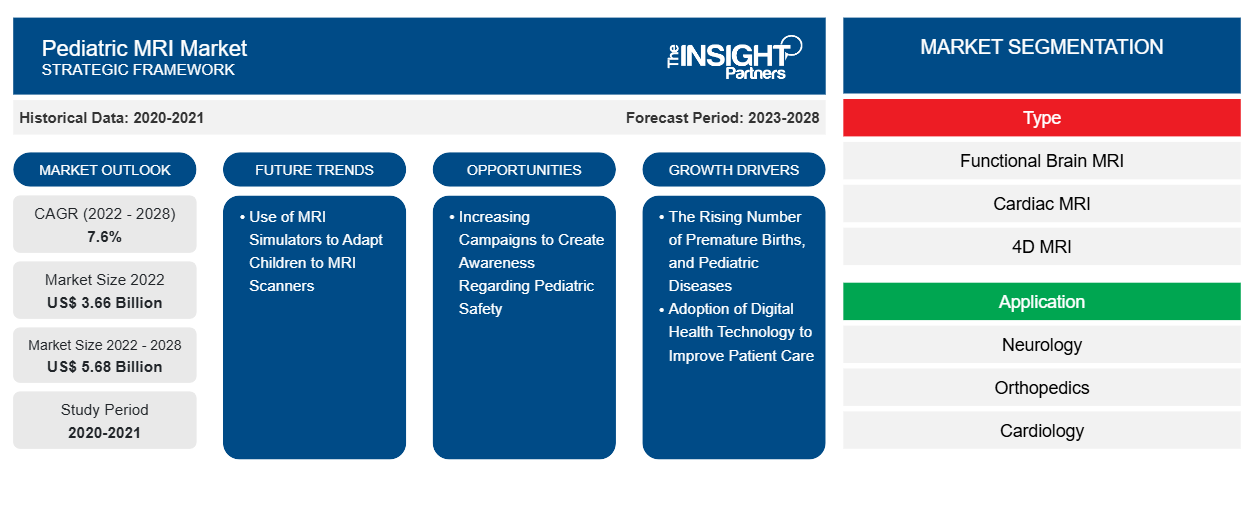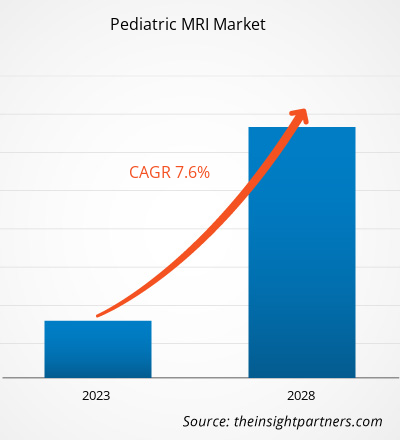[Forschungsbericht] Der Markt für pädiatrische MRT wurde im Jahr 2022 auf 3.655,32 Millionen US-Dollar geschätzt und soll bis 2028 5.678,86 Millionen US-Dollar erreichen; von 2022 bis 2028 wird eine durchschnittliche jährliche Wachstumsrate (CAGR) von 7,6 % erwartet.
Analystenperspektive:
Die steigende Belastung durch Frühgeburten und pädiatrische Erkrankungen, die Nachfrage nach fortschrittlichen Gesundheitspraktiken in der Kinderpflege, staatliche Initiativen zur Sensibilisierung für pädiatrische Erkrankungen und die zunehmende Verbreitung neuartiger pädiatrischer Bildgebungsverfahren sind einige Schlüsselfaktoren, die das Wachstum des Marktes für pädiatrische MRT vorantreiben . Darüber hinaus wird erwartet, dass der zunehmende Fokus der Marktteilnehmer auf die Entwicklung neuer Produkte und strategische Kooperationen zur Entwicklung fortschrittlicher pädiatrischer MRTs das Marktwachstum in den kommenden Jahren ankurbeln wird. Regional betrachtet hält Nordamerika den größten Marktanteil bei pädiatrischen MRTs, gefolgt von Europa. Aufgrund der zunehmenden Fälle von Frühgeburten in Ländern wie China und Indien wird jedoch erwartet, dass der asiatisch-pazifische Raum im Prognosezeitraum die höchste durchschnittliche jährliche Wachstumsrate auf dem Markt für pädiatrische MRTs verzeichnen wird.
Marktübersicht:
Die pädiatrische Magnetresonanztomographie (MRT) verwendet ein Magnetfeld, Radiowellen und einen Computer, um detaillierte Bilder des Körperinneren eines Kindes zu erzeugen. Sie wird zur Diagnose oder Überwachung der Behandlung verschiedener Erkrankungen des Gehirns, der Brust, des Bauches, des Beckens, angeborener Anomalien und der Extremitäten verwendet. Das Wachstum des pädiatrischen MRT-Marktes wird auf einige wichtige treibende Faktoren zurückgeführt, wie die steigende Zahl von Frühgeburten und Kinderkrankheiten sowie die Einführung digitaler Gesundheitstechnologien zur Verbesserung der Patientenversorgung. Darüber hinaus können die zunehmenden Kooperationen und Produkteinführungen zur Verbesserung der Kinderversorgung das globale Wachstum des pädiatrischen MRT-Marktes ankurbeln. Die zunehmenden Kampagnen zur Sensibilisierung für die Sicherheit von Kindern werden voraussichtlich auch im Prognosezeitraum reichlich Möglichkeiten für das Wachstum des pädiatrischen MRT-Marktes in den Regionen bieten.
Passen Sie diesen Bericht Ihren Anforderungen an
Sie erhalten kostenlose Anpassungen an jedem Bericht, einschließlich Teilen dieses Berichts oder einer Analyse auf Länderebene, eines Excel-Datenpakets sowie tolle Angebote und Rabatte für Start-ups und Universitäten.
- Holen Sie sich die wichtigsten Markttrends aus diesem Bericht.Dieses KOSTENLOSE Beispiel umfasst eine Datenanalyse von Markttrends bis hin zu Schätzungen und Prognosen.
Markttreiber:
Steigende Zahl von Frühgeburten und Kinderkrankheiten treibt das Wachstum des Marktes für Kinder-MRT voran
Frühgeburten werden vor Vollendung der 37. Schwangerschaftswoche lebend geboren. Die meisten Frühgeburten finden in Südasien und Afrika südlich der Sahara statt. Mehrere Faktoren wie Mehrlingsschwangerschaften, Infektionen und chronische Erkrankungen können zu Frühgeburten führen und in den letzten Jahren ist dies zu einem globalen Problem geworden. Frühgeburten können das Wachstum von Babys beeinträchtigen. Laut Bericht der Weltgesundheitsorganisation (WHO) werden jedes Jahr etwa 15 Millionen Frühgeburten geboren. Der Bericht gab auch an, dass in etwa 184 Ländern eine Frühgeburtenrate von 5–18 % der Babys vorliegt und über 60 % der Frühgeburten im asiatisch-pazifischen Raum und in Afrika verzeichnet werden. Außerdem sterben jedes Jahr etwa 1 Million Babys an Komplikationen bei Frühgeburten. Komplikationen bei Frühgeburten sind die häufigste Todesursache bei Kindern unter fünf Jahren und waren 2019 für etwa 900.000 Todesfälle verantwortlich. Nach Angaben der Centers for Disease Control and Prevention (CDC) war im Jahr 2021 etwa jedes zehnte in den USA geborene Kind von einer Frühgeburt betroffen. Die Frühgeburtenrate stieg 2021 um 4 %, von 10,1 % im Jahr 2020 auf 10,5 % im Jahr 2021. Laut WHO lag die Frühgeburtenrate bei 4 % bis 16 % der im Jahr 2020 geborenen Babys.
Die Magnetresonanztomographie (MRT) ist ein wertvolles Instrument, um die Entwicklung des Gehirns eines Frühgeborenen zu überwachen. Mit dieser Bildgebungsmethode können zahlreiche Pathologien wie periventrikuläre Leukomalazie, intraventrikuläre Blutungen und periventrikuläre hämorrhagische Infarkte beurteilt werden. Laut einer Studie mit dem Titel „MRI Identifies Markers of Atypical Brain Development in Children Born Preterm“, die in der Radiological Society of North America veröffentlicht wurde, weisen Frühgeborene, die als Teenager Autismus, Zerebralparese und andere Anomalien entwickeln, nur minimale Unterschiede in ihren Gehirnstrukturen auf, die mithilfe der quantitativen MRT (qMRT) erkannt werden können. Laut WHO starben im Jahr 2019 etwa 5,2 Millionen Kinder unter fünf Jahren an vermeidbaren und behandelbaren Krankheiten. Kinder unter fünf Jahren sind anfällig für Infektionskrankheiten wie Malaria, Durchfall, Lungenentzündung, HIV und Tuberkulose. Laut UNICEF ist Lungenentzündung die häufigste Infektionstodesursache bei Kindern unter fünf Jahren. Jährlich sterben etwa 700.000 Kinder an dieser Krankheit. Bei rechtzeitiger Diagnose sind diese Erkrankungen jedoch vermeidbar oder behandelbar.
Die zunehmende Zahl an Frühgeburten und die steigende Prävalenz pädiatrischer Erkrankungen fördern die Nutzung der pädiatrischen MRT, was wiederum das Marktwachstum antreibt.
Segmentanalyse:
Basierend auf dem Typ ist der Markt für pädiatrische MRT in funktionelle Gehirn-MRT (fMRT), Herz-MRT, 4D-MRT und andere unterteilt. Das Segment der funktionellen Gehirn-MRT (fMRT) hatte 2022 den größten Anteil am Markt für pädiatrische MRT. Es wird jedoch erwartet, dass das 4D-MRT-Segment zwischen 2022 und 2028 die höchste durchschnittliche jährliche Wachstumsrate verzeichnet. Das Marktwachstum für das Segment wird auf die zunehmende Frühgeburt und die zunehmende Inzidenz traumatischer Hirnverletzungen weltweit zurückgeführt. Die funktionelle Magnetresonanztomographie (fMRT) konzentriert sich ausschließlich auf das Gehirn und zeichnet die Stoffwechselaktivität im Laufe der Zeit auf. Die fMRT misst die geringfügigen Veränderungen des Blutflusses, die bei Gehirnaktivität auftreten. Sie untersucht die funktionelle Anatomie des Gehirns, prüft die Auswirkungen von Schlaganfällen und anderen Krankheiten und leitet die Gehirnbehandlung. Die fMRT hat auch das Verständnis der Forscher für Entwicklungswege bei Kindern und die Plastizität neuronaler Netzwerke in Krankheitszuständen verbessert. Andererseits verbessern 4D-medizinische Bildgebungstechniken die Leistung der MRT über drei Dimensionen hinaus, indem sie Zeitinformationen einbeziehen. Bei Kindern mit pulmonaler Hypertonie besteht bei jeder Katheterisierung das Risiko eines Herzinfarkts. Die 4D-MRT ermöglicht eine umfassende Auswertung komplexer Blutflussmuster und eine flexible retrospektive Quantifizierung von Flussparametern.
Basierend auf der Anwendung ist der Markt für pädiatrische MRT in Kardiologie, Orthopädie, Neurologie, Onkologie und andere unterteilt. Das Segment Neurologie hatte im Jahr 2022 den größten Marktanteil für pädiatrische MRT und wird in den kommenden Jahren voraussichtlich die höchste durchschnittliche jährliche Wachstumsrate verzeichnen. Das Marktwachstum für das Segment wird durch die zunehmenden Fälle traumatischer Verletzungen vorangetrieben, die schnellere und genauere Bildgebungslösungen erfordern. Bei Verletzungen und Erkrankungen des Gehirns, des Halses, der Wirbelsäule und des Nervensystems hilft die Neurobildgebung, Genauigkeit sicherzustellen. Die pädiatrische Neurobildgebung erfordert eine Spezialisierungsebene, da mit der Entwicklung des Gehirns viele Feinheiten verbunden sind. Zu den neurologischen Anwendungen der Magnetresonanztomographie gehören die Diagnose von Rückenmarks- und Hirntumoren, Entzündungen, Infektionen, Verletzungen und mehr. Die MRT ist auch hilfreich bei der Erkennung und Überwachung degenerativer neurologischer Erkrankungen wie Multipler Sklerose und bei der Dokumentation von Hirnverletzungen infolge eines Traumas.
Basierend auf dem Produkttyp ist der Markt für pädiatrische MRT in Geräte und Spulendesign unterteilt. Das Gerätesegment hatte 2022 einen größeren Marktanteil und wird voraussichtlich zwischen 2022 und 2028 eine höhere CAGR verzeichnen. Das Marktwachstum für das Segment ist auf die verschiedenen Vorteile zurückzuführen, darunter geringere Risiken bei der pädiatrischen und fetalen Bildgebung, ein geringerer Bedarf an Sedierung und erneuten Scans sowie ein optimierter Patientenkomfort, insbesondere für pädiatrische Patienten. MRT-Geräte für die Pädiatrie ermöglichen sichere Techniken zur Einschränkung und Immobilisierung der Bewegung der Halswirbelsäule bei Kindern, um Patienten mit Wirbelsäulenverletzungen oder Fixierung effektiv zu positionieren, zu transportieren und zu immobilisieren.
Basierend auf der Altersgruppe ist der Markt für pädiatrische MRT in das fetale Stadium, das neonatale Stadium (0–27 Tage), Säuglinge und Kleinkinder (28 Tage–23 Monate), Kinder (2–11 Jahre) und Jugendliche (12–18 Jahre) unterteilt. Das Segment der Jugendlichen (12–18 Jahre) hatte im Jahr 2022 den größten Marktanteil. Es wird jedoch erwartet, dass das Segment der Kinder (2–11 Jahre) im Prognosezeitraum die höchste durchschnittliche jährliche Wachstumsrate verzeichnet. Das Marktwachstum für das Segment der Jugendlichen (12–18 Jahre) ist auf die zunehmende Zahl traumatischer Verletzungen zurückzuführen, die die Nachfrage nach schnelleren und präziseren Bildgebungslösungen ankurbeln. Es wird jedoch erwartet, dass der Markt für das Segment der Kinder (2–11 Jahre) in den kommenden Jahren aufgrund der zunehmenden Zahl von Verletzungen, Krankheiten und angeborenen Anomalien bei Kindern wachsen wird. Laut dem im Februar 2022 veröffentlichten Artikel mit dem Titel „Neuroblastombehandlung“ liegt die Prävalenz eines Neuroblastoms bei etwa 1 Fall pro 7.000 Lebendgeburten. Die Inzidenz beträgt bei Kindern unter 15 Jahren 10,54 Fälle pro 1 Million pro Jahr. Der gleichen Quelle zufolge sind etwa 90 % der Patienten bei der Diagnose unter fünf Jahre alt.
Basierend auf dem Endnutzer ist der Markt für pädiatrische MRT in Krankenhäuser, Kinderkliniken, Diagnosezentren und andere unterteilt. Das Krankenhaussegment hatte 2022 den größten Marktanteil und wird im Prognosezeitraum voraussichtlich die höchste durchschnittliche jährliche Wachstumsrate (CAGR) von 8,0 % auf dem Markt verzeichnen. Das Marktwachstum für das Krankenhaussegment ist auf die zunehmende Verbreitung verschiedener Krankheiten, die zunehmende Zahl von Krankenhäusern weltweit und das rasche Wachstum verschiedener chirurgischer Verfahren zurückzuführen. Auch die wachsende staatliche Finanzierung von Krankenhäusern und die zunehmende Krankenhauseinweisung von pädiatrischen Patienten unterstützen das Wachstum des Marktes für pädiatrische MRT.
Regionale Analyse:
Nordamerika hatte im Jahr 2022 den größten Anteil am Markt für pädiatrische MRT. Es dominiert den globalen Markt aufgrund von Faktoren wie technologischen Fortschritten, zunehmenden Produkteinführungen, gut entwickelten Gesundheitseinrichtungen, die mit modernen Geräten und Instrumenten ausgestattet sind, und technologischen Fortschritten, die maximalen Patientenkomfort gewährleisten. Die USA haben den größten Anteil am Markt für pädiatrische MRT in Nordamerika aufgrund der wachsenden technologischen Fortschritte bei pädiatrischen Bildgebungstechniken und der zunehmenden Kooperationen, Zulassungen und Markteinführungen zur Verbesserung der pädiatrischen Versorgung. Darüber hinaus treiben die steigende Zahl von Frühgeburten, die zunehmende Verbreitung von Kinderkrankheiten und die hohe Nachfrage nach Lösungen für Präventivpflege und Bildgebung die Nachfrage nach pädiatrischen MRT-Systemen in den USA an.
Darüber hinaus wird erwartet, dass der Markt für pädiatrische MRTs im asiatisch-pazifischen Raum in den kommenden Jahren deutlich wachsen wird. Das Marktwachstum in der Region ist auf die steigende Zahl der Kinder und Verbesserungen der Gesundheitsinfrastruktur durch die zunehmende Verfügbarkeit effektiver pädiatrischer Bildgebungsinstrumente zurückzuführen. China und Japan tragen maßgeblich zum regionalen Markt für pädiatrische MRTs bei. China steht aufgrund rascher sozioökonomischer Entwicklungen, Umweltproblemen, veränderter Lebensstile und zunehmender Urbanisierung vor mehreren Hindernissen bei der Erhaltung und Verbesserung der Gesundheit der Menschen. Auch Verkehrsunfälle mit Verletzungen bei Kindern sind in China ein großes Problem für die öffentliche Gesundheit. Unfälle bei Kindern können zu traumatischen Hirnverletzungen führen, was den Markt für pädiatrische MRTs in China voraussichtlich ankurbeln wird. Darüber hinaus hat Japan einen enormen Anstieg der Verkehrsunfälle gemeldet, was die Nachfrage nach pädiatrischen MRTs im Land antreibt. Sie wird zur Diagnose einer Vielzahl von Erkrankungen bei Kindern eingesetzt, die durch Verletzungen, Krankheiten oder angeborene Anomalien verursacht werden. Sie erkennt eine Vielzahl von Hirnerkrankungen und -anomalien wie Zysten, Tumore, Blutungen, Schwellungen und Probleme mit den Blutgefäßen. Die oben genannten Faktoren fördern das Wachstum des Marktes für pädiatrische MRT in Japan.
Schlüsselspieleranalyse:
Der Markt für pädiatrische MRT besteht hauptsächlich aus einigen wenigen Akteuren wie Siemens Healthineers AG, Advanced Imaging Research Inc, LMT Medical Systems GmbH, Hyperfine Inc, GE HealthCare Technologies Inc, Neoscan Solutions GmbH, Aspect Imaging Ltd, NORAS MRI products GmbH, Koninklijke Philips NV und Time Medical Holding. GE HealthCare Technologies Inc und Koninklijke Philips NV sind aufgrund ihres diversifizierten Produktportfolios die beiden größten Akteure auf dem Markt.
Regionale Einblicke in den Markt für pädiatrische MRT
Die regionalen Trends und Faktoren, die den Markt für pädiatrische MRTs im Prognosezeitraum beeinflussen, wurden von den Analysten von Insight Partners ausführlich erläutert. In diesem Abschnitt werden auch die Marktsegmente und die Geografie für pädiatrische MRTs in Nordamerika, Europa, im asiatisch-pazifischen Raum, im Nahen Osten und Afrika sowie in Süd- und Mittelamerika erörtert.

- Erhalten Sie regionale Daten zum Markt für pädiatrische MRT
Umfang des Marktberichts zur pädiatrischen MRT
| Berichtsattribut | Details |
|---|---|
| Marktgröße im Jahr 2022 | 3,66 Milliarden US-Dollar |
| Marktgröße bis 2028 | 5,68 Milliarden US-Dollar |
| Globale CAGR (2022 - 2028) | 7,6 % |
| Historische Daten | 2020-2021 |
| Prognosezeitraum | 2023–2028 |
| Abgedeckte Segmente | Nach Typ
|
| Abgedeckte Regionen und Länder | Nordamerika
|
| Marktführer und wichtige Unternehmensprofile |
|
Marktteilnehmerdichte für pädiatrische MRT: Auswirkungen auf die Geschäftsdynamik verstehen
Der Markt für pädiatrische MRTs wächst rasant, angetrieben durch die steigende Nachfrage der Endnutzer aufgrund von Faktoren wie sich entwickelnden Verbraucherpräferenzen, technologischen Fortschritten und einem größeren Bewusstsein für die Vorteile des Produkts. Mit steigender Nachfrage erweitern Unternehmen ihr Angebot, entwickeln Innovationen, um die Bedürfnisse der Verbraucher zu erfüllen, und nutzen neue Trends, was das Marktwachstum weiter ankurbelt.
Die Marktteilnehmerdichte bezieht sich auf die Verteilung der Firmen oder Unternehmen, die in einem bestimmten Markt oder einer bestimmten Branche tätig sind. Sie gibt an, wie viele Wettbewerber (Marktteilnehmer) in einem bestimmten Marktraum im Verhältnis zu seiner Größe oder seinem gesamten Marktwert präsent sind.
Die wichtigsten auf dem Markt für pädiatrische MRTs tätigen Unternehmen sind:
- Siemens Healthineers AG
- Advanced Imaging Research Inc
- LMT Medical Systems GmbH
- Hyperfine Inc
- GE HealthCare Technologies Inc
Haftungsausschluss : Die oben aufgeführten Unternehmen sind nicht in einer bestimmten Reihenfolge aufgeführt.

- Überblick über die wichtigsten Akteure auf dem Markt für pädiatrische MRT
Aktuelle Entwicklungen:
Anorganische und organische Strategien wie Fusionen und Übernahmen werden von Unternehmen im pädiatrischen MRT-Markt häufig eingesetzt. Nachfolgend sind einige aktuelle wichtige Marktentwicklungen aufgeführt:
- Im März 2023 eröffnete Time Medical offiziell seine neue Produktionsstätte in Hongkong im MARS Centre im Tai Po INNOPARK. Damit wird es zur ersten groß angelegten Produktionsstätte für medizinische Geräte in Hongkong und zur größten MRT-Produktionsbasis in der Greater Bay Area und Südostasien. Die Produktionsstätte ist auf Forschung und Entwicklung sowie die Produktion von supraleitenden MRT-Systemen mit hoher Wertschöpfung für Neugeborenen- und Brustkrebs-Screening spezialisiert.
- Im Februar 2023 erhielt Hyperfine, Inc. die CE-Kennzeichnung für das Swoop-System, das weltweit erste von der FDA zugelassene tragbare MRT-System. Während das Unternehmen seinen kommerziellen Fokus auf die USA legt, öffnet die CE-Kennzeichnung die Tür für eine mögliche kommerzielle Expansion in den Europäischen Wirtschaftsraum (EWR).
- Im Februar 2023 erhielt Time Medical die US-Zulassung der FDA für sein neonatales MRT-System NEONA. Es ist das weltweit erste supraleitende MRT-System speziell für die pädiatrische Diagnostik und kann die Präzision und Bildqualität empfindlicher Neugeborener, Säuglinge und Kinder deutlich verbessern. Diese Innovation ist leicht und kompakt genug, um in eine Neugeborenen-Intensivstation zu passen, wodurch das Gesundheitsrisiko, das mit dem Transport junger Patienten verbunden ist, erheblich reduziert wird.
- Im Juni 2022 erhielt Hyperfine, Inc. die FDA 510(k)-Zulassung und brachte neue Sequenzen für das Swoop-System auf den Markt, die die Fähigkeiten des Systems erweitern und kürzere Gehirnscan-Zeiten für Patienten ermöglichen. Die neue Software des Systems nutzt Deep Learning, um scharfe, klare Bilder zu liefern, die bei der klinischen Diagnose helfen.
- Im Juni 2022 schloss Hyperfine, Inc. die Registrierung und Benachrichtigung des Swoop-Geräts in Australien und Neuseeland ab. Mit dieser Aktivität ist das Swoop-System nun in beiden Ländern zum Kauf erhältlich und enthält die von der US-amerikanischen FDA zugelassene fortschrittliche Rekonstruktionssoftware mit Deep Learning. Quantum HealthCare wurde zum Produktdistributor des Unternehmens für Australien und Neuseeland.
- Historische Analyse (2 Jahre), Basisjahr, Prognose (7 Jahre) mit CAGR
- PEST- und SWOT-Analyse
- Marktgröße Wert/Volumen – Global, Regional, Land
- Branche und Wettbewerbsumfeld
- Excel-Datensatz


- Public Key Infrastructure Market
- Batter and Breader Premixes Market
- Pharmacovigilance and Drug Safety Software Market
- Redistribution Layer Material Market
- Aesthetic Medical Devices Market
- Energy Recovery Ventilator Market
- Pipe Relining Market
- Cosmetic Bioactive Ingredients Market
- Personality Assessment Solution Market
- Nuclear Waste Management System Market

Report Coverage
Revenue forecast, Company Analysis, Industry landscape, Growth factors, and Trends

Segment Covered
This text is related
to segments covered.

Regional Scope
North America, Europe, Asia Pacific, Middle East & Africa, South & Central America

Country Scope
This text is related
to country scope.
Häufig gestellte Fragen
The global pediatric MRI market, based on type, is segmented into functional brain MRI (fMRI), cardiac MRI, 4D MRI, and others. The functional brain MRI (fMRI) segment held the largest share of the market in 2022. However, the 4D MRI segment is anticipated to register the highest CAGR during the forecast period.
The pediatric MRI market was valued at US$ 3,655.32 million in 2022.
The pediatric MRI market is expected to be valued at US$ 5,678.86 million in 2028.
The factors driving the growth of the pediatric MRI market include the rising cases of premature births and pediatric disease and the adoption of digital health technology to improve patient care. However, limitations and safety challenges associated with pediatric MRI hamper the growth of the pediatric MRI market.
Pediatric MRI uses a powerful magnetic field, radio waves, and a computer to produce detailed images of the child's body. MRI is used to diagnose or monitor treatment for a variety of conditions within the chest, brain, abdomen, pelvis, and extremities. It is also used for imaging the joints and bones to diagnose sports-related injuries or to detect the presence of a tumor or infection in a joint.
The pediatric MRI market majorly consists of the players, including Siemens Healthineers AG, Advanced Imaging Research Inc, LMT Medical Systems GmbH, Hyperfine Inc, GE HealthCare Technologies Inc, Neoscan Solutions GmbH, Aspect Imaging Ltd, NORAS MRI products GmbH, Koninklijke Philips NV, and Time Medical Holding.
Trends and growth analysis reports related to Life Sciences : READ MORE..
The List of Companies - Pediatric MRI Market
- Siemens Healthineers AG
- Advanced Imaging Research Inc
- LMT Medical Systems GmbH
- Hyperfine Inc
- GE HealthCare Technologies Inc
- Neoscan Solutions GmbH
- Aspect Imaging Ltd
- NORAS MRI products GmbH
- Koninklijke Philips NV
- Time Medical Holding
The Insight Partners performs research in 4 major stages: Data Collection & Secondary Research, Primary Research, Data Analysis and Data Triangulation & Final Review.
- Data Collection and Secondary Research:
As a market research and consulting firm operating from a decade, we have published and advised several client across the globe. First step for any study will start with an assessment of currently available data and insights from existing reports. Further, historical and current market information is collected from Investor Presentations, Annual Reports, SEC Filings, etc., and other information related to company’s performance and market positioning are gathered from Paid Databases (Factiva, Hoovers, and Reuters) and various other publications available in public domain.
Several associations trade associates, technical forums, institutes, societies and organization are accessed to gain technical as well as market related insights through their publications such as research papers, blogs and press releases related to the studies are referred to get cues about the market. Further, white papers, journals, magazines, and other news articles published in last 3 years are scrutinized and analyzed to understand the current market trends.
- Primary Research:
The primarily interview analysis comprise of data obtained from industry participants interview and answers to survey questions gathered by in-house primary team.
For primary research, interviews are conducted with industry experts/CEOs/Marketing Managers/VPs/Subject Matter Experts from both demand and supply side to get a 360-degree view of the market. The primary team conducts several interviews based on the complexity of the markets to understand the various market trends and dynamics which makes research more credible and precise.
A typical research interview fulfils the following functions:
- Provides first-hand information on the market size, market trends, growth trends, competitive landscape, and outlook
- Validates and strengthens in-house secondary research findings
- Develops the analysis team’s expertise and market understanding
Primary research involves email interactions and telephone interviews for each market, category, segment, and sub-segment across geographies. The participants who typically take part in such a process include, but are not limited to:
- Industry participants: VPs, business development managers, market intelligence managers and national sales managers
- Outside experts: Valuation experts, research analysts and key opinion leaders specializing in the electronics and semiconductor industry.
Below is the breakup of our primary respondents by company, designation, and region:

Once we receive the confirmation from primary research sources or primary respondents, we finalize the base year market estimation and forecast the data as per the macroeconomic and microeconomic factors assessed during data collection.
- Data Analysis:
Once data is validated through both secondary as well as primary respondents, we finalize the market estimations by hypothesis formulation and factor analysis at regional and country level.
- Macro-Economic Factor Analysis:
We analyse macroeconomic indicators such the gross domestic product (GDP), increase in the demand for goods and services across industries, technological advancement, regional economic growth, governmental policies, the influence of COVID-19, PEST analysis, and other aspects. This analysis aids in setting benchmarks for various nations/regions and approximating market splits. Additionally, the general trend of the aforementioned components aid in determining the market's development possibilities.
- Country Level Data:
Various factors that are especially aligned to the country are taken into account to determine the market size for a certain area and country, including the presence of vendors, such as headquarters and offices, the country's GDP, demand patterns, and industry growth. To comprehend the market dynamics for the nation, a number of growth variables, inhibitors, application areas, and current market trends are researched. The aforementioned elements aid in determining the country's overall market's growth potential.
- Company Profile:
The “Table of Contents” is formulated by listing and analyzing more than 25 - 30 companies operating in the market ecosystem across geographies. However, we profile only 10 companies as a standard practice in our syndicate reports. These 10 companies comprise leading, emerging, and regional players. Nonetheless, our analysis is not restricted to the 10 listed companies, we also analyze other companies present in the market to develop a holistic view and understand the prevailing trends. The “Company Profiles” section in the report covers key facts, business description, products & services, financial information, SWOT analysis, and key developments. The financial information presented is extracted from the annual reports and official documents of the publicly listed companies. Upon collecting the information for the sections of respective companies, we verify them via various primary sources and then compile the data in respective company profiles. The company level information helps us in deriving the base number as well as in forecasting the market size.
- Developing Base Number:
Aggregation of sales statistics (2020-2022) and macro-economic factor, and other secondary and primary research insights are utilized to arrive at base number and related market shares for 2022. The data gaps are identified in this step and relevant market data is analyzed, collected from paid primary interviews or databases. On finalizing the base year market size, forecasts are developed on the basis of macro-economic, industry and market growth factors and company level analysis.
- Data Triangulation and Final Review:
The market findings and base year market size calculations are validated from supply as well as demand side. Demand side validations are based on macro-economic factor analysis and benchmarks for respective regions and countries. In case of supply side validations, revenues of major companies are estimated (in case not available) based on industry benchmark, approximate number of employees, product portfolio, and primary interviews revenues are gathered. Further revenue from target product/service segment is assessed to avoid overshooting of market statistics. In case of heavy deviations between supply and demand side values, all thes steps are repeated to achieve synchronization.
We follow an iterative model, wherein we share our research findings with Subject Matter Experts (SME’s) and Key Opinion Leaders (KOLs) until consensus view of the market is not formulated – this model negates any drastic deviation in the opinions of experts. Only validated and universally acceptable research findings are quoted in our reports.
We have important check points that we use to validate our research findings – which we call – data triangulation, where we validate the information, we generate from secondary sources with primary interviews and then we re-validate with our internal data bases and Subject matter experts. This comprehensive model enables us to deliver high quality, reliable data in shortest possible time.


 Holen Sie sich ein kostenloses Muster für diesen Bericht
Holen Sie sich ein kostenloses Muster für diesen Bericht